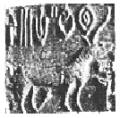It is almost a century ago that the Indus Valley Culture came to light, during the construction of a railway in the Punjab of then British India, near Lahore. Huge piles of baked bricks of different shapes and sizes of abnormal length and width drew the attention of the workers, with the result that ultimately the area was spared and the railway line was diverted. Harappa, in Sindh, was discovered by Dayaram Sahni in 1921, though information about the site was already available since the end of the nineteenth century. Earlier, in 1850, information of such a ruin and a vast mound of burnt bricks had drawn some attention when its owner, residing in Delhi, wanted to sell that land off for nothing. No one was interested in owning that abandoned land of ruin. The site was first excavated by Sir John Marshall as the Director General of the Archaeological Survey of India together with his team when an astonishing treasure of finds and remains of human settlement of a very ancient age came to light.
The site was named Harappa, though it was located near the ancient center of knowledge, Taxla or Takshashila. Much of the surface material was gone including the bricks that were taken away by the nearby inhabitants leaving a deserted area of no value of Harappa. No one wished to resettle over there considering it an ill-fated place. While digging the adjoining sites, more bricks appeared and there seemed to come no end to it. After removing some of the material, walls and roads appeared and also the layout for a whole township with a well-planned drainage system, with ovens for melting ores, wells, water reservoirs, a granary, agricultural tools, wheels, carts as toys and many more figures and figurines. Some grains, broken bangles, earrings, ornaments, some stone beads and necklaces, earthenware, weights and measures, records, seals and sealings etc., all indicating some well established human community which hadlong been in ruins and had never been taken any care of since. Later, M. S. Vats took up the excavations with his team.
Rakhal Das Banerjee soon discovered another, identical site, named Mohenjo-Daro. Sir John Marshall worked on both the sites from where excavation brought the oldest and culturally most advanced human civilization to light. This second site was towards Karachi with a harbor-like trade city named Mohenjo-daro - which meant the Mount of the Dead. There too a rich treasure of ancient finds came to light on excavation, explored under the leadership of John E. Mackay. Being in the area of Sindh and Punjab the sites were given the name (Sindhu)/ Indus. Both Marshall and Vats made beautiful catalogues of their investigated finds, while preserving the original finds in the local museum, now known as the Taxla Museum.
Thus, Indian, British, American and French archaeologists together brought the mysterious Indus Valley Culture to light. M. S. Vats, E. J. H. Mackay, Mortimer Wheeler, S. R. Rao, B. B. Lal, R. S. Bisht and a long list of other explorers have thereafter discovered very many sites of Indus repute from where identical finds are recovered. The explorers not only brought the sites to light, but also the finds in their best form as cleaned objects, making them available for study. It is a real bliss that all the finds were carefully collected, washed, cleaned, sorted, photographed and all the information was recorded in catalogues for further study. Those catalogues give information about a great treasure and have been taken under study by this researcher together with the available information from the other excavation sites which were excavated after the partition of India and Pakistan. Both the countries continued to explore more and more sites for identical finds. More than 400 sites are on record of the ASI and ASP so far, considered now as belonging to that so called sleeping culture.
Various Indus sites like Mohenjo-daro, Harappa, Lothal, Kalibangan, Banawali, Amri, Daimabad, Dholavira, Desalpur, Djoka, Chanhu-daro, Chandigarh, Alangirpur, Jhukar, Hulas, Lohunju-daro, Kish, Khir-sara, Lothal, Maski, Mehi, Mithathal, Nala-dera, Pabumath, Prabhaspatan, Tarkanewala-dara, Surkotada, Shahi tumb, Susa, Siswal, Rajdi, Rangpur, Rakhigarhi, Rohida, Rupar, Telloh, Ur, thus came to light. Far away from the Indus Andhra Pradesh located Kanvamatakkal, Tamil Nadu located Kilvalai, and Sri Lanka located Jaffna etc..
It were the days of British India then, hence the British had the leading involvement in the explorations. Scholars from the whole world took interest in understanding more of that culture and in script, to get some information of worldly gain and about some hidden treasure. Mainland Europeans took the lead however, Max-Mueller being the leading German. Germans took great interest in relation to their Aryan theory and the similarity of some signs prevalent in the Celtic–Italian world, like the unicorn, the cross, the sand watch, etc., and the alleged Gundestrup Cauldron sketch of the 2nd century BC (?), thus taking pride of their supposed ancestral relationship with the Indus Art.
After independence and the separation of Pakistan from India, that treasure fell into the divided territory of the new nation, Pakistan. The Indian government was not in a situation to divert attention from the refugees and the starving public with a totally neglected economy, agriculture, health, and infrastructure, and with poverty, new problems of settlements, jobs, education, and recovering from the shock of devastation that took place in the wake of the Partition. Whoever extended a hand of friendship in the fields of education, industrialization, cultural exchange, explorations, science, agriculture, etc., and took interest in exploring more sites in the remaining territory under friendship was entertained. European, Japanese, Chinese, Russian and American teams cooperated with the ASI. And thus new sites with ample material surfaced to expand and study it for this most ancient civilization.
The texts were massive in quantity from each excavation site, to begin with Harappa and then Mohenjo-daro. To systematize the handling of the signs, their sites of availability and location on the seal with other signs in sequence to realize their reference to a context for interpretation of any sign in particular, one felt the necessity of some code listing. Thus came up the Sign Manual of Sir John Marshall in 1931 for Indus signs from the finds from Mohenjo-daro, marking out the main or basic signs. By 1940 Madho Sarup Vats independently published his sign manual of the finds of Harappa on the same basis. Both these manuals with their text indices help the beginners to acquaint their eyes with the Indus signs and to reach the exact sign text to see for oneself and to identify the signs, as they were still unknown to most of the modern world. Each sign is very important for its shape in conveying the message when used alone or with modification.
Iravatham Mahadevan dealing with all these manuals classified these and finally composed his own Sign Manual to report his observations regarding each sign for its special sequence in the texts to reflect its value as suffix and prefix, and availability, classifying the signs through their shapes giving out his nine points Concordance as well as the sign list commenting upon the total signs with their classification on basis of their shapes, sites of appearance along with their sign itself. The syllabic phonetic lists are drawn differently by each decipherer, each independently, without uniformity and applying a great stretch of imagination and their own presumptive approaches.
The sign manuals, one made by Sir John Marshall, another made by M. S. Vats showing some 450 signs, and a third by G.L. Possehl displaying the total texts of the seals are all incomplete. The US based museum director G. L. Possehl published his own Sign Manual, indexing the total sign texts available then. It became easy to add newly discovered texts with its index number, site of recovery and sign details for reference. All these manuals are very useful. Asko Parpola from Finland with Jagat Pati Ghosh gave a Sign List in 1978 as an enriching addition to the Sign Manual of Mahadevan by adding some newly discovered Indus Signs.
In Pakistan also newer sites were explored. Encouraged by their attempts a long list of explorers jointly began exploration on the Indus Valley Culture and many tried to read the script. They achieved success in their own way of giving phonation to the signs and composing lexicons, but none of them could read a single seal text successfully and sensibly to their own satisfaction.
We wish to mention some names from the long list of thousands of researchers engaged in deciphering the ancient scripts who also gave attention to the Indus script:
Script
Decpiherer
Egyptian, Hieroglyphic
Champollion, Forrer and Bossert
Hittite, Hierpglyphic and Cuneiform
Archibald Henry Sayce Hroznet
Ugaritic (Syrian), Cuneiform
Hans Bauver
Phoenician, also Cuneiform
Dhorme
Cretan, as Linear A and Linear B
Michael Ventris, John Chadwick
Clay Tablets
Arthur Evans
Sumerian, Cuneiform
Jules Oppert
Turkey-Lion stone, as Hittite, Hieroglyphic and Phoenician
Helmut Theoder, Bossert
Cypro Minovan, as Cyporite
Duo de Lyunes
Siberian, as Siberian script
Thomson
Greek Mycenaean Linear B
Mychael Ventris and John Chadwick
Avestan, old Persian
Grotefend
Semitic, as Cuneiform
Hans Bauver and Dhorme
Mayan
Y. Knorozov
Prakrit and Tamil as Brahmī
James Princep
Among other readers are Marshall himself, who read 200 tablets/ seals with the help of Sumerian and Brahmī, as he claimed. Ultimately he declared Indus script, as Boolee and also Waddell considered it, as resembling the ancient Egyptian. Kinnier Wilson, Ross, Hansmann, Wheeler and Piggot, believed Indus script to have an Indo-Sumerian link and that most of the seals carried only proper names. No one thought it to be wholly Indic. Feeling sensitive, Indian scholars considered it as under Vedic influence, the Rig Veda being the oldest available text. McDonnell, believing in a totemic culture in pre-Aryan India, attached importance to the elephant as field animal on seals as a possible indication of Hittite/ Hatti (Hebrew/ Greek). He defined the Aryans as the advanced people who took agriculture as their occupation and rode on carts and chariots, while the Dasyu were those who did good handcrafts and did not believe in the Vedas. Gearson, working on the Kashmiri manual, realized that the Kashmiri language has also four cases, like the German and Latin, but unlike Sanskrit. Indus is pre-Vedic; hence Indus should be related to German and Latin.
However, the Rig Veda being the oldest book available, all the scholars got conveyed to decipher the Indus script through a Vedic approach, applying the Brahmanistic sūtra technique only. In doing so, they wholly forgot that the Rig Veda was composed by compiling earlier written Saṁhitas. It was thus not the first text. The Indus finds have removed that curtain of misconceptions.
Definite Grammar rules were already there in form of Nighantus along with the Saṁhitas and Niryuktis, and languages were very well developed. Each seal reflects the Pre-Rigvedic, Sanatana religion, known as śramanism prevailing on earth at that time. The hero of the Rig Veda was Rishabha, first as king and later as śramana. The Indus finds reveal the sky-clad (nude) śramans who often roamed around to reach the remote hill peaks for penance. Communication though was easy with the regional languages, yet the śravakas evolved a symbolic language to remind the purpose of life to lonely śramans and also had that inscribed on rock beds as well as in the form of souvenirs. Rishis lived in āśramas, munis in forests, as is evident from the later literature of the Mahābhārata. The ancient traditional resemblance of Indus culture continues even today of śramanas in the Jain tradition hence it became very necessary to try to interpret the Indus texts in a śramanic way as well. Such an approach has ended successfully.
With the compilation of the Vedas surfaced a new religion known as Brahmanism, and thus the two streams, śramanism and Brahmanism became the oldest cultures of Bharatavarsha (India). More than 2500 years ago Buddhism came into existence, and its bhikkhus were also addressed as śramanas; hence the ancient jina śramanism being the follower of jinas took the new name of Jainism. But out of all religions the Indus tradition is reflected wholly only in Jainism renouncing it as the root culture and the root religion of the human civilization. The causes of confusion were the commonly used terminology in the two religions for KARMA and MOKSHA with are completely different concepts. Karma in śramanism is the root cause of all the troubles to the soul (jīva), being a pollutant, and all efforts are made to set the soul free from it, through renunciation and penance as also shown in the Indus texts. In Brahmanism karma is favored as duty of life, against the Indus texts.
Dr. M. S. Mishra tried to read Indus script with the application of the Rigvedic Sūtras, Maheshwar Sūtras, the gayātrī and the anushtup meters. Dr. S. R. Rao made an effort by reading it with Rigvedic vocabulary, S. M. Punekar by applying details of the Purānas and the Vedic influence on texts from Mohenjo-daro, R. Madhivanan read the Harappan script as Kanneluttu and Koleluttu by making a link with the Tamil and Dravid languages. He thinks that the merchants and the chieftains issued the seals and that those religious people worshipped the Sun and the Moon, but built no temples. The Aryan invasion theory caused a rift between the North and South Indians, and a lobby of Dravid pride appeared with great love for the Indus culture, which fetched support from some western scholars as well. N. Jha and N. S. Rajaram read it for resemblance of a few signs with Brahmī. Mahadevan deciphered a few signs in his own way with the help of the Purānic literature, calling the signs themes, but no syllabi. Pathak and Verma read it through the tribal hymns and songs. Dr. Ramvilas Sharma noticed the snake and Garuda in the Indus seals and considered the two as the Gana signs, living harmoniously in those ancient days, evidencing that nonviolence was prevalent then. The Naga or snake cult was popular in the period of Krishna, though Garuda has never been taken as a symbol of nonviolence. Dr. T. V. Mahalingam also noticed the snake and Garuda sitting together as depicted in an Indus seal and considered it a symbol of harmony in those days.
Pundit Rahul Sanskratyayan mentioned that since the ancient past some Dravids migrated to the North soon after the cooling of the lava of the Southern Plateau and got settled in Komi, Finland and Estonia! Living in the cold they became fair and their dark thick hair became thin and reddish, but their features remain the same as Dravids. This suggestion connected Finland and Europe with India. B. V. Subbarayappa considered that the texts of seals could be the quantitative records of the agricultural produce stored in their granaries. The Indus script represents no language in his view, though Rigvedic rishis might be descendants of the Harappan priestly class. But all their approaches fail because they are Brahmanistic.
A. B. Keith tried to read it as influenced by the ritualism of the Vedas. Thus scholars from all over the world, from the fields of anthropology, history, philosophy, linguistics, engineering and technology, epigraphy, archaeology, humanities, paleography, ecology and naturally from museums, the administration and from archaeological surveys got engaged in projects, jointly as well as independently, but no encouraging results could be achieved by them so far that led to the deciphering of the Indus script - in spite of the rich collection of seals and other artifacts.
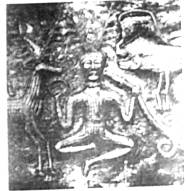

The Gundestrup Cauldron (ca. 150 BC) is no match with Indus art of seal
Andrew Robinson in 2002 published a book entitled Lost Languages; The Enigma of the World’s Undeciphered Scripts, (McGrawHill, 2002) in which he displayed linear signs with their phonetic values. But hardly five of his signs have resemblance with the Indus basic signs.
The wide ranged availability of Indus signs in the region, even appearing in the Sumerian documents and as far away as Mesopotamia and the Persian Gulf led Hansmann to think of an Indo-Sumerian link.
Wheeler and Piggot supported the argument that perhaps commodities like bronze, gold, faience, carnelian, beads, ivory pottery etc. were exchanged between India and Sumer through these seals.
Kinnier Wilson was of the opinion that both types of scripts, Indus and Sumerian, originated from the same root. He considered the Indus sign  as the unit of measure, say ‘Q’, then
as the unit of measure, say ‘Q’, then  or
or  as 3Q,
as 3Q, as 6Q,
as 6Q,  or
or  as 10 Q and
as 10 Q and  as 5Q,
as 5Q,  being taken as 5;
being taken as 5;  as 10,
as 10,  as 20 and
as 20 and  as 2;
as 2;  as the la sign and
as the la sign and  as the ban la sign.
as the ban la sign.
A. S. Ross daringly compared the Indus texts with Sumerian economic texts and tried to interpret with Mesopotamian signs
with Mesopotamian signs  as identical (?) signs for a unit of measure! Also, he interpreted
as identical (?) signs for a unit of measure! Also, he interpreted  as bad-imins or city wall / 7 walls / 7 cities. They all hence, first tried their own methods to decipher the Indus script and later took the most appropriate Indic way to handle it.
as bad-imins or city wall / 7 walls / 7 cities. They all hence, first tried their own methods to decipher the Indus script and later took the most appropriate Indic way to handle it.
Indus being Indic, they had to adopt the Indic approach only. Since the Rig Veda is the oldest known written book every scholar took interest in learning Sanskrit, and then studied the Vedas, the Upanishads or Vedānta, and tried to decipher the Indus texts applying sūtras for theme values in a Vedic way. Sutras are shorthand expressions of large themes and require acquaintance with the Indian culture. Hence, a wave of “Hare Krishna, Hare Rama” captivated the youth of the world, attracting the younger generation towards Hindu yoga and religion. All these approaches were post-Vedic, hence failed. Bailey added to this by suggesting a connection between the Rig Vedic phrase of ‘sapta sindhvas’ and the Avesta one of ‘hepta hindu’ i.e. high places, hence giving further support for the presumed applicability of the Vedic approach.
Many foreign universities announced scholarships for indology, inviting Indian scholars of young age and sometimes some senior fellowships too, but, for want of some bilingual key, no fruitful results in the field of deciphering the Indus script came. The Indus Valley Culture thus opened not only a new field of studies for its unknown culture that attracted scholars as well as religious leaders. Religious leaders were also invited from abroad for delivering lectures to acquaint the public interested in knowing Indian metaphysics. Unfortunately those religious leaders were equally ignorant of the Indus message. I too was invited and had my lecture series on my new research held in Hamburg (1999), New York (2007 and 2008) and Boston (2008).
Language offers a very strong medium of communication. That language can be of the eyes, of gestures, of the body (head or limb movements, facial expressions etc.), phonation of any type, or a physical expression, or even pictorial, symbolic, conventional or ideogrammatic types of expression. The expression should always convey some meaning. Even the dumb and deaf have their intelligible language.
Unfortunately, Jains appear to be equally unconcerned about their traditional rich heritage as those who adhere to the Vedic or the Dravid explanation. In spite of my several appeals to the Śravana Belagola ASI authorities and the local maintainers of the rich Indus heritage, no care is given, nor any protection to the inscriptions and reliefs. On the contrary important features meanwhile became damaged under carelessness, in few years. The other Jain sites suffer equal neglect as far as their Indus keys are concerned. Even when reminded, no one seems to be serious to preserve any of their own priceless heritage. It is very important to record the remaining śramana heritage in time, before further damage is done.
J. M. Kennoyer looked over rock inscriptions for his studies. He reported the presence of some of the same rock inscriptions as those seen on Indus seals on many hill sites in Iran and Pakistan. Both the countries were part of the ancient Bharatavarśa (India). Even earlier to his reporting I noticed some interesting markings on some South Indian Jaina pilgrimage sites and on some māna-stambhas (pillars) and jina images - which I have reported through my articles in the Jain magazines. Later, I realized that those designs were symbolic and very much similar to some Indus signs. Luckily one of signs I studied matches with the reported find of J. M. Kennoyer which he calls the ‘womb-sketch’ because it looks like a womb. Finding it in the temple site of Śravana Belagola of Karnataka where I found the key of the Indus signs, and observing its similarity with the Bhuvalaya Yantra, I gave it the same name. Asko Parpola supported the theory of the Indo-Aryan language replacing the Indus.
 1
1 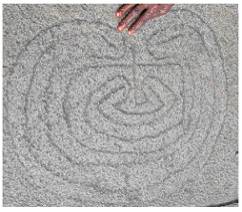 2
2
Based on the other ancient languages, some daring scholars such as G. L. Possehl came out with their own sign phonation lists for the Indus signs; some researchers, like Madhivanan, Mahadevan, Possehl, Jha emphasized that the Indus script shows an influence of the Dravid script, but not a single sign resembles the Dravid script in form. Also the phonetic relation goes beyond presumption, in any case with account to the different regional languages. Studies of this type should be taken up by the scholars, not rigid as Vedic scholars, but those open to and acquainted with Pre-Vedic literature as well.
We know that the Saṁhitas, Nighantus, Niryuktis, Sūtras and the symbolic languages existed even earlier than the Vedas like the śramanas contemporary to Brahmins. Ignoring them one cannot receive the Indus message. The world appeared to have totally forgotten the ancient śramanas, though wherever excavations are made śramanic remains boom and jina images damaged and some times intact and safe, are found.
A simple way of exploring the reading technique for Indus script should have been that, when one method failed, the other should have been fully followed till the end. When all the before-mentioned Western and Vedic approaches, including Nighantu, Niryukta, Brāhmana, Vedāntic, Upanishadic, Puranic, the Sūtras, Mantras, Chhand and the Mahābhārata etc. failed to support the transcription of the Indus script, the only alternative indigenous approach left was the śramanic approach, what several scholars like Ram Prasad Chandra, Muni Vidyanand Balbhadra, Prof. M.S. Ramaswami Ayangar, Heinrich Zimmer and William, Buehler etc. very aptly suggested, directly or indirectly. Why the scholars did not pay attention was perhaps either of two reasons: their ignorance, or intentional neglect - and both are not excusable for scholars. If they know the important names of the ancient śraman world, like Rishabh, Arihant, Arishtanemi etc. then they are aware of their importance in the śramanic literature too. If the Rig Veda, the Brāhmanas, Nighantu, Niryukti, the Pitakas and Jātakas could survive the odds of nature then the Dwadaś-aṅga, the twelve major scriptures of Jainism could also survive - unless intentionally destroyed (like the jina busts seen in the Indus finds from Mathura Kankali Tila or from Pataliputra). All these facts deserve deep and careful analysis.
However, their neglect has caused them to lose a whole century with nothing but frustration. One must begin to look through the pre-Vedic window to get the Indus panorama in which ascetics were moving in groups or alone towards the remote mountains or to the river banks away from the worldly attractions determined to undergo penance. Even today we have chances to witness such scenes when the jina śramans pass by some towns; perhaps the decipherers never had any such experience in their life. Jina śramans are seen even today to get their reflection on the Indus seals. An indologist must be at least aware of all such evenrs including the ancient Indian traditional ways, especially when very often during excavations jina images are dug up in heaps.
Well-known linguists like M. V. N. Krishna Rao, S. R. Rao, N. Jha, N. S. Rajaram, Madhu Sudan Mishra, Madhivanan, Punekar, Vakankar, Verma and Pathak, Mahadevan, W. A. Fairservis, Ojha, B. B. Lal, S. P. Gupta, G. L. Possehl, and many more who claim to have deciphered the Indus script have not become satisfied with their own work, because they could not look beyond the frail curtain of the Rig Veda and adopted endless stretches of imagination for convincing themselves and others. None of them so far could find a single key to unlock the mystery of the Indus texts. No one could, while reading the text as shown below, read the text of a single seal correctly and sensibly, i.e. in full detail, without missing any feature from the texts.

The Egyptian stone of Rosetta carrying script in three languages (Hieroglyphic, Coptic and Greek), solved the mystery of deciphering the Egyptian hieroglyphic language thanks to our knowledge of Greek. In Sri Lanka a bilingual metal seal was reported by Professor Indrapala of Jaffna University, through excavations at Anaikotai, Jaffna, in 1981 which carried Indus texts in the upper line with a Brahmī text of 3 signs in the lower line - but I see that total text in Indus script only! - taken as a key to read the Indus texts in the way of the Brahmī script. But how is that possible if the Jaffna metal seal presents Indus signs only?
Jaffna text 
The first part of the Jaffna text shows three renunciate arhatas (possibly Shanti, Kunthu and Araha), who have reached the second Śukla Dhyāna [i.e. the second stage of pure contemplation] because the second part of the seal shows them in the environment of Ardha Chakris. The three were Chakris, rulers, as per Jain scriptures.
The Jain scriptures give a totally different account of the evolution of languages. The Ādipurana mentions Rishabh, the Ādi Brahmā, as the beginner of the languages and scripts. He taught 18 scripts to his sons and daughters, including Devanāgarī with 700 dialects which were already prevalent in his period. He is addressed as Brahmā, Mahadev, Vishnu, Paramhaṁsa, Prajāpati, Pashupati etc. in the Rig Veda (from which the Hindu mythology originates). His daughter Sundarī initiated the new science of numbers based on 1 to 9, decimals and also the zero to express the numerical values in calculations. She was the founder of the three types of mathematics. Her blood brother Bahūbali, who had a big physical size, was an expert astrologer. Astrology cannot survive without mathematics. The other step-sister, Brahmī, gave birth to the Brahmī script. Both the sisters became virgin nuns while the brothers in a later period of their life also became ascetics accepting renunciation. The original Brahmī script, later gave birth to the various newer languages including Sanskrit, other than the earlier 18 ones. Brahmī was worshipped as Brahmanī Devī and ruins of the ancient Brahmanī Devī Temple are found on the hill near Ravi. The Rig Veda hence all through mentions that Rishabh and Vrashabha advise wise persons of availing company, even of scholarly women. The name Bhārata Varśa to what is now called India was given after the name of Bharat, the eldest son of Rishabh.
A proverb says: “One sees the world according to the glasses one puts on one’s eyes.” Not necessarily everyone will put on glasses of the same color.
In the case of reading the Indus script everyone wanted to superpose his own view point on others with full authority with no permissible limit of freedom for trial. Mahadevan is only a toddler so far Indus script is considered to be deciphered by him because he sails in the same boat as others like Jha or Mathivanan, Marshall or Possehl, Parpola or Fairservis, Mishra or Rao. Unless the meaning of signs uniformly leads the decipherers to some sensible message all efforts and funds with whatever time spent go wasted. My suggestion is just to try the śramanic approach and see the miracle.
Whatever is the valuable contribution so far by all the earlier Indus scholars is useful for bringing the seals and their texts to light with great patience and hard work. Making catalogues was another great task. Then drawing the sign lists and sorting out the texts was also not easy. Well, so far everything was fine. Mahadevan’s Concordance to sort out signs was another great contribution. But insisting all the time to impose their childish interpretation to the high theme symbols with an endless stretch of imagination in name of Vedic application or of the Mahābhārata by Jha, or of Dravid and Tamil influence by Mahadevan and Mathivanan with a great lobby of ignorant supporters seems to be a very narrow viewed effort. Similarly Fairservis trying to interpret the most ancient signs in term of modern western approach brings the whole Indus height to grounds. He suggests that 6th Millennium BC (Period of Mahavir and Buddha which had in India already reached a climax of cultural awareness and democracy) India started agriculture and then suggests the Indus script as beginning of Art of writing!
The funniest of all is that considering oneself a hero, everyone wants the other to put effort only supporting his work - which means to put the feet in their shoes to walk ahead. Gossip with endless stretch of imagination should not be permitted in the name of “probable deciphering” to overrule other researchers. The Indus script now seen on jina images makes all the decipherers dwarf. See how: The seals that are alleged to have been read so far are shown separately for their petty interpretations given earlier so far.
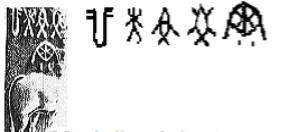 | From right to left: |
Reference: Dr. Rajbali Pandeya: Bhartiya Puralipi, 1978, Lok Bharati Prakashan, Allahabad, and Dr. R. Madhivanan: Indus Script Dravidian, 1990, Tamil Chanror Peravai, Madras.
2.
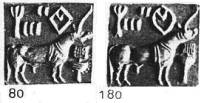 also
also 
Katah
All these texts are, in spite of their morphological differences, read by Dr. Natwar Jha as Katah = Katuh (Reference: The Deciphered Indus Script, Aditya Prakashan, New Delhi). With a śramanic approach the texts mean that under the shelter of the flag of the jina Rishabh, one can float as cream atop in the Bhava Ghata achieving the second śukla dhyāna [pure concentration] from the third dhyāna of a high level śravaka by observing ratnatraya, i.e the ‘three jewels’ of right vision, right knowledge, right conduct.

Kanah
These texts differ in meaning in that under the shelter of the jina Rishabh the two śukla dhyānas of omniscience are achieved by a four dharma-dhyāni ascetic [i.e. an ascetic with four spiritual contemplations –ed.] ratnatraya.

These four Indus seal texts give different messages when reading them in the śrāmanic way:
The first seal expresses that one can float up in the Bhava-Ghata (to end migrating), achieving the second śukla dhyāna (of omniscience) by remembering the pañcha parameshthi [the five supreme souls: arhanta, siddha, āchārya, upādhyāya [student], sādhu ed.]) or the Namokar Mantra and keep observing the ratnatraya.
Seal # 198 expresses that a nikat bhavya yogi always remains prepared for sallekhana [self-chosen peaceful death by fasting –ed.]] with faith in the six dravyas [i.e. the six substances: motion, non-motion, space. Matter, life, and time –ed.] or existences: while observing ratnatraya.
Seal # 238 expresses that the environment of a nikat bhavya yogi achieving the second śukla-dhyāna has always seven tattvas [i.e. the seven principles: life, non-life, inflow of karmas, bondage, to existence, stopping the inflow of karmas, and exhaustion or dissolution of karmas –ed.] in his thinking with observation of ratnatraya.
Seal # 267 expresses that a lingering soul in Jambu Dwīpa, the central island of the middle world (between heavens and hells) which has three dharma-dhyānas can strive for, and become an arhat, earning eight merits, observing the ratnatraya.
3.


The text of seal # 474 has five features, as the upper three on the face and the lower two on the back are most precisely giving the Jaina message. The arrow showing self-reservation, only leads to siddhahood (shown by a bold dot) and arihanthood (denoted by a perpendicular line), the line of supremacy or arhata. The lower line shows the Bhava-ghata, and the triple lines denotes three dharma-dhyānas. The seal text message is then: The self-control can in practice be imposed by oneself in home life, social life as well as ascetic life, though it is difficult. An elephant even can be controlled by an ankush. Similarly the desires need the control of vows which need to be fulfilled by oneself by great mental control. Everywhere self-control comes first. The text here reads:
By self-restriction only can one become a siddha or an arhata, for which one begins with three dharma-dhyānas to float as cream in the Bhava ghata final.
4.
Fairservis and Mahadevan unnecessarily lay too much stress is on the beginning sign and the ending sign in the seal texts, where they consider the spear as the closing sign! This could have been true if it were a weapon for violence, but it is instead a symbol for self-reservation, and is the beginning for the life of any ascetic or śraman. Equally it is useful in a śravaka’s life Their final aim ever was and is to achieve nirvāṇa or salvation or mokṣa “floating like cream in a container filled with whey”, the mundane world being called as Bhavasagar but the Indus artist prefers to show it as the Bhava-ghata [destruction or existence], to be towards the end of the text Hence the seal is as shown above under point 3.or in the following cases where they are read from left to right with the śramanic approach.
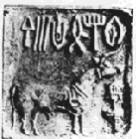 | The text reads from left to right: With self-restraint a householder with three dharma-dhyānis became a yogi and, adopting pañchāchāra finally performed the Lokapuram whirl of a kevali prior to reaching salvation. |
.
| Again the text reads from left to right: Entering into self-restriction a householder with three dharma-dhyānis ultimately achieved the second śukla dhyāna (for becoming an omniscient arhat) to float as cream on the top in the Bhava ghata, in this very Jambu Dvīpa [the central island - which includes the earth on which we live.] |
5.
In the above shown seals the yogi is, though missing, always present as a kayotsargi [standing ascetic meditator]. The fish is shown to express the defenselessness of life against the karmaphala chetana - i.e. the consciousness of the reaping of karma - as in seal #19;
. 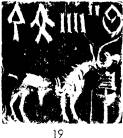
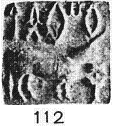 112 jina Chakra
112 jina Chakra
or:
He has to impose some restraints on himself to gain improvement under the flag of the jina Rishabh;
or:
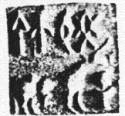
such as to be a kevali [omniscient person] he has to make Adamya purushārtha [effort] even as an āryika [ grandfather; ascetic]; or:
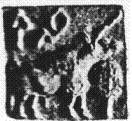
self-restraint is conditional for undergoing sallekhana under the flag of the jina Rishabha; one requires self-restraint to become a kayotsargi yogi under the flag of the jina.


Seeing all these examples one realizes that all other approaches fail in reading the Indus texts convincingly while the śramanic approach succeeds in giving them sensible meanings.
6.
The flag here is a chakra [wheel] and the so-called field animal is the symbol of the tīrthankara [greatest and holiest teacher –ed.].

Seal #112 Reads L-R. Under the shelter of the jina chakra of the Tīrthakara Rishabh with self-restriction, an ascetic in the Ratnatrayi Jambu Dwīpa underwent renunciation and penance, and from this very Jambu Dwīpa found his way to salvation.
7.
Some more Harappan seals bearing a text beginning with a spear, and some other seals from Mohenjo-daro, as reported by Mackay, carry a spear at the beginning of the texts where self-restraint is most necessary for entering into the disciplined life of an ascetic/ śramana or even as a householder/ śravaka.
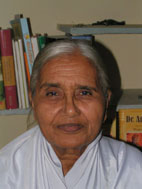 Dr. Sneh Rani Jain
Dr. Sneh Rani Jain
